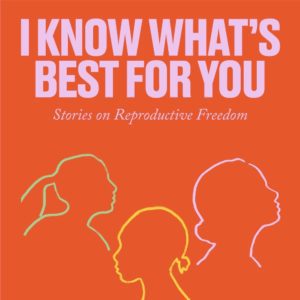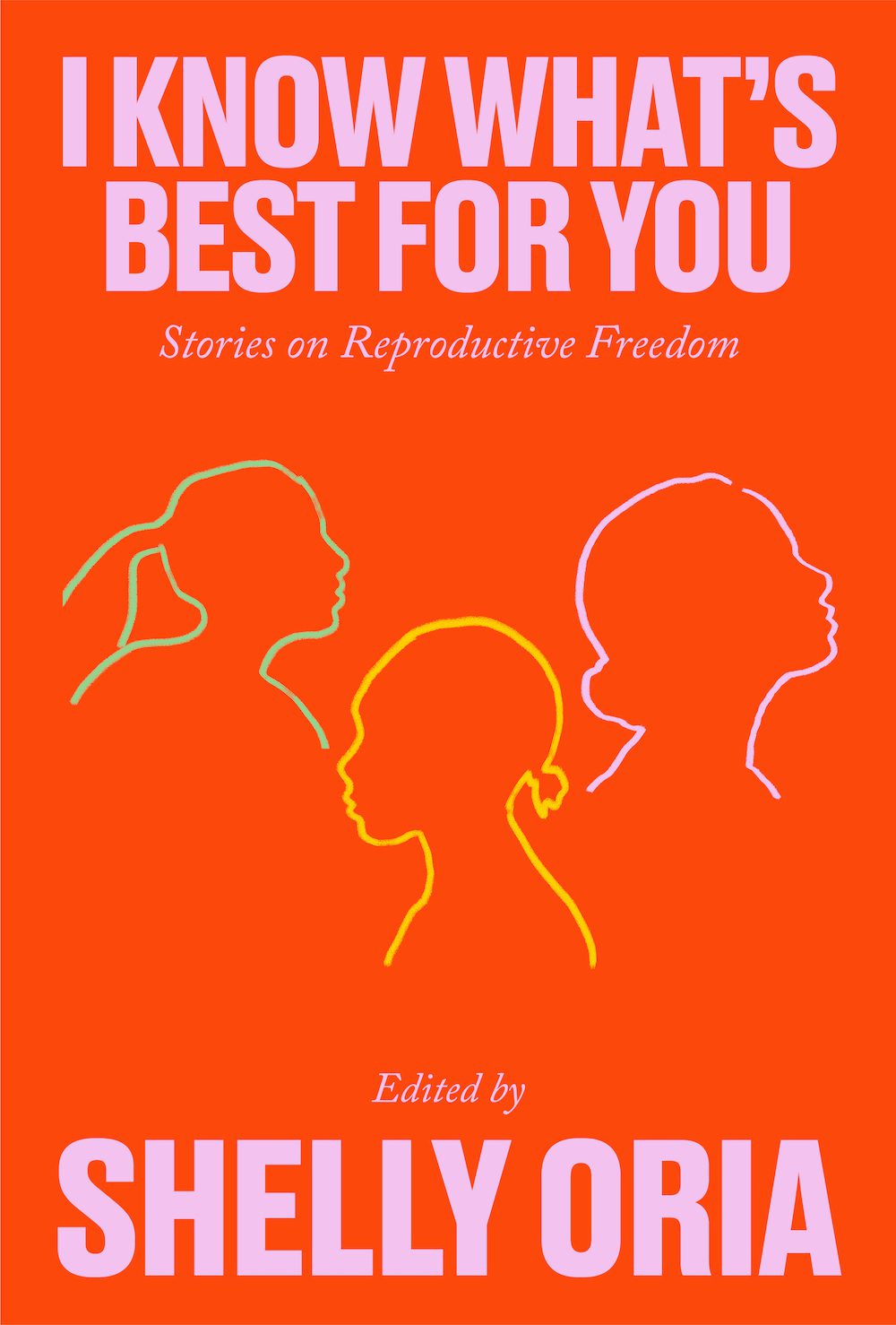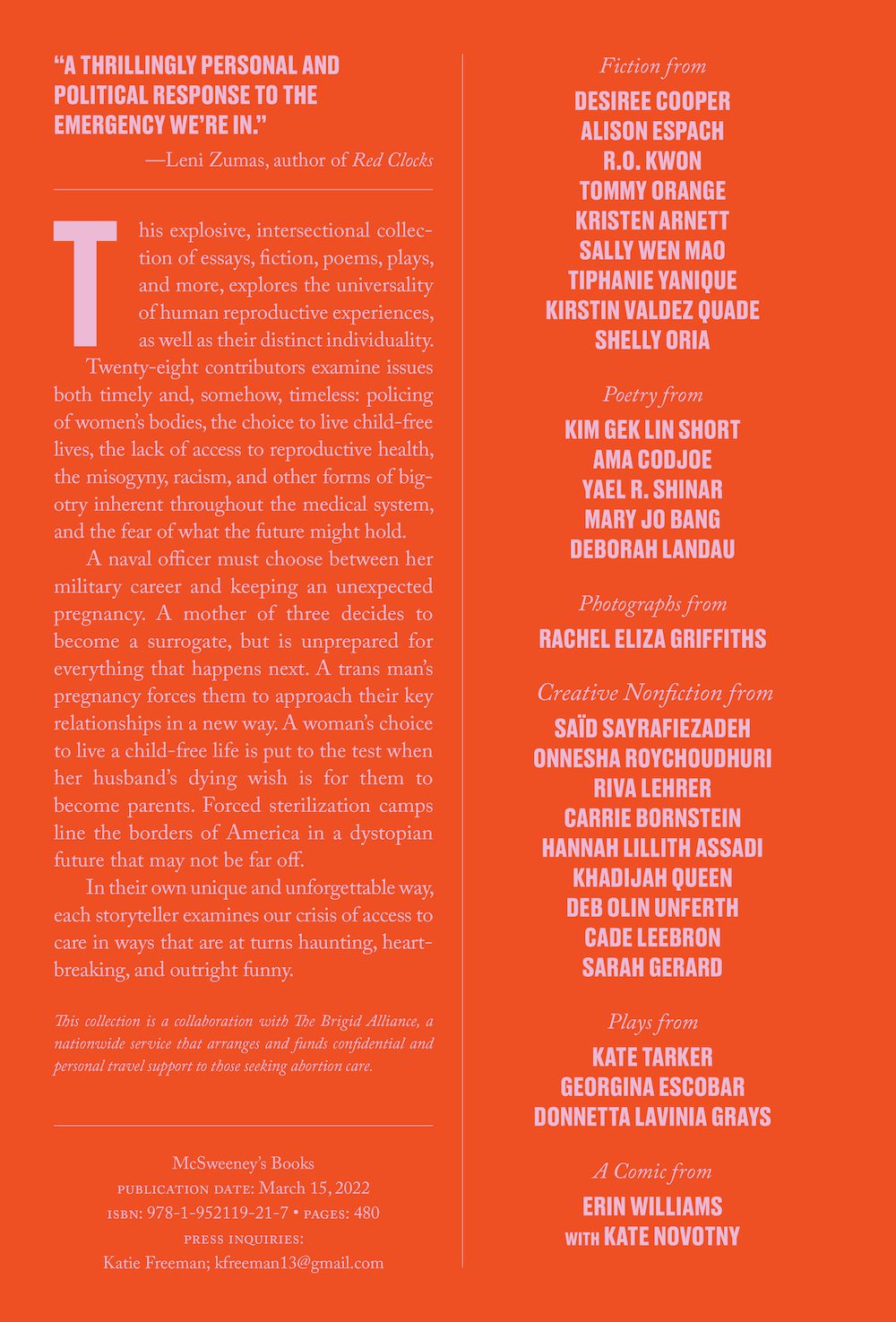
Books are soulful beings that come into our fast world slowly. While they’re being written, revised, edited, copyedited, and published, the world around them shape-shifts.
When I began to curate the forthcoming I Know What’s Best for You: Stories on Reproductive Freedom at the end of 2019, I would often calm myself down by watching videos of Ruth Bader Ginsburg performing TRX push-ups. She’s well, the videos would whisper to me, She’s strong. Breathe. The world, since then, has changed its shape.
A few months earlier, on a sunny Saturday, I met Carol Davis for lunch in Manhattan’s West Village. Carol cofounded The Brigid Alliance—a nonprofit that arranges and pays the way for individuals across the country forced to travel for abortion care—and now she was discussing with McSweeney’s a potential collaboration: an anthology that would respond to our urgent reproductive freedom crisis. I’d just curated and edited another anthology for McSweeney’s, Indelible in the Hippocampus: Writings from the Me Too Movement, and Amanda Uhle, McSweeney’s Publisher, asked if I’d take on this new project, a book she hoped would be similar in format and spirit. I arrived at that lunch thinking I was versed in the topic of reproductive freedom, that I understood our crisis and its circumstances. But as I listened to Carol, I realized the situation was far more dire than I knew.
According to the Center for Reproductive Rights, if Roe v. Wade were overturned, twenty-four states could immediately prohibit abortion. When you consider that laws restricting abortion are being enacted at an alarming rate—forty-six laws in eighteen states in the first nine months of 2019 alone—the terror intensifies. And have you heard of fake clinics? According to US reproductive rights organization Reproaction, there are currently about 2,700 anti-abortion centers across the country—more than three times the number of clinics that provide abortion care—many of which masquerade as abortion clinics, so they may promote their agenda in all kinds of effective ways, such as suggesting a woman take time to consider her options and scheduling her next appointment for a date when her pregnancy would be too advanced to terminate legally.
One could put together a powerful book—ten powerful books—filled with stories of abortion or the lack of access to one in today’s America. But I felt drawn to a broader approach and invited writers and artists to respond to any aspect of reproductive freedom with which they connected: miscarriages, fertility, contraception, surrogacy, childfreeness… and, of course, abortion. My experience with Indelible in the Hippocampus offered insight that made this wide lens feel essential.
In 2017, when millions of people around the globe were sharing #MeToo stories and I began curating Indelible in the Hippocampus for McSweeney’s, I sought to make a book that would elevate that movement’s message and also address its lack of inclusivity; at the time, the stories of white, straight, beautiful actresses dominated our cultural conversation to the point of distortion (even though a Black woman, Tarana Burke, founded the movement in 2006). Making an inclusive anthology—with voices that spanned backgrounds, races, genders, and ages—became even more important to everyone involved. And when Indelible in the Hippocampus came out, when I discussed it or read from it alongside other writers and activists in different cities around the country, it was, in fact, the book’s intersectionality that seemed to draw in most readers.
It was at those same events, listening to womxn share their stories, witnessing mothers and daughters who showed up together—so many mothers and daughters, and seeing them wrecked me like nothing else on that tour—that an even bigger narrative began to crystallize. It seemed clear that every aggression they described lived within a context of oppression. That sexual violence against womxn is one of innumerable mechanisms that ensure womxn hold less power than men.
And yet I operated—and the movement seemed to operate—as though there were a finite number of abusers and, if our society exposed and punished them all, our work would be done.
There is a dotted line connecting the powerful Hollywood producer in his robe to every other man who has abused his power and harmed womxn and their bodies. This isn’t to say that these men and their stories are the same. It’s to suggest that you can follow that dotted line of oppression to Texas, where a six-week abortion ban that recently went into effect forces any Texas resident who needs an abortion to travel for one—or give birth. You can follow the line to One First Street in DC, where the heavily conservative Supreme Court will soon be hearing what many view as a test case to overturn Roe.
As we continue our cultural conversation on reproductive health, as it perhaps heightens over the coming months and years, my hope is that we fight the terrible symptom while keeping in mind the larger illness that produces it: a system in which certain bodies hold inherent power over other bodies.
It is understandable, of course, that we tend to focus on symptoms of societal illnesses more than we focus on the connections among them; seeing those connections can cause paralyzing despair. But if the goal is to see and insist on that larger context without despairing, then that is where art becomes essential.
The stories in I Know What’s Best for You—the short fiction and personal essays, the poems and plays, the comics and photographs in the book—have deepened and changed my understanding of reproductive freedom. Not only that, but they managed to do so while making me laugh, while somehow, against all odds, inspiring optimism. We need writers and artists now, more than ever, to offer new ways of thinking about, feeling into, and responding to the state of emergency in which we find ourselves. That is the power of storytelling, the power of art, at its best: it transcends the limitations of any given moment in time. No matter what shape the world has taken by March, when the book is released, I hope it helps you rise above the restrictions of that moment, and believe that reproductive freedom is possible.
***
Excerpted from I Know What’s Best for You: Stories on Reproductive Freedom, edited by Shelly Oria. Copyright © 2022 by Shelly Oria. Reprinted by permission, courtesy of McSweeney’s.
[Essay has been revised by author for reprinting. – Ed.]






